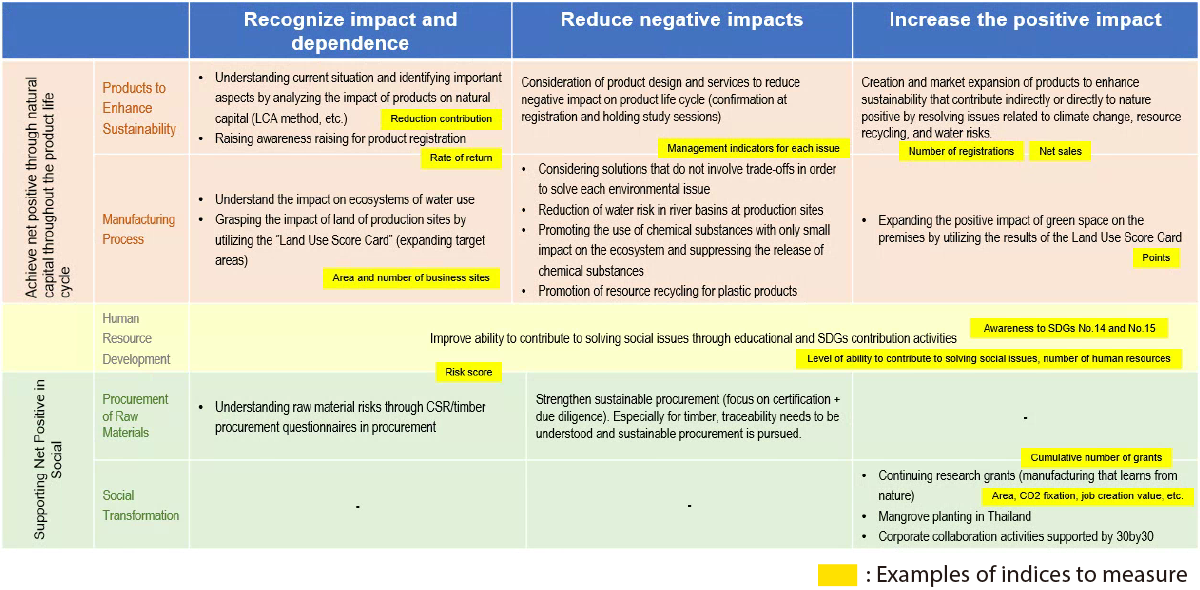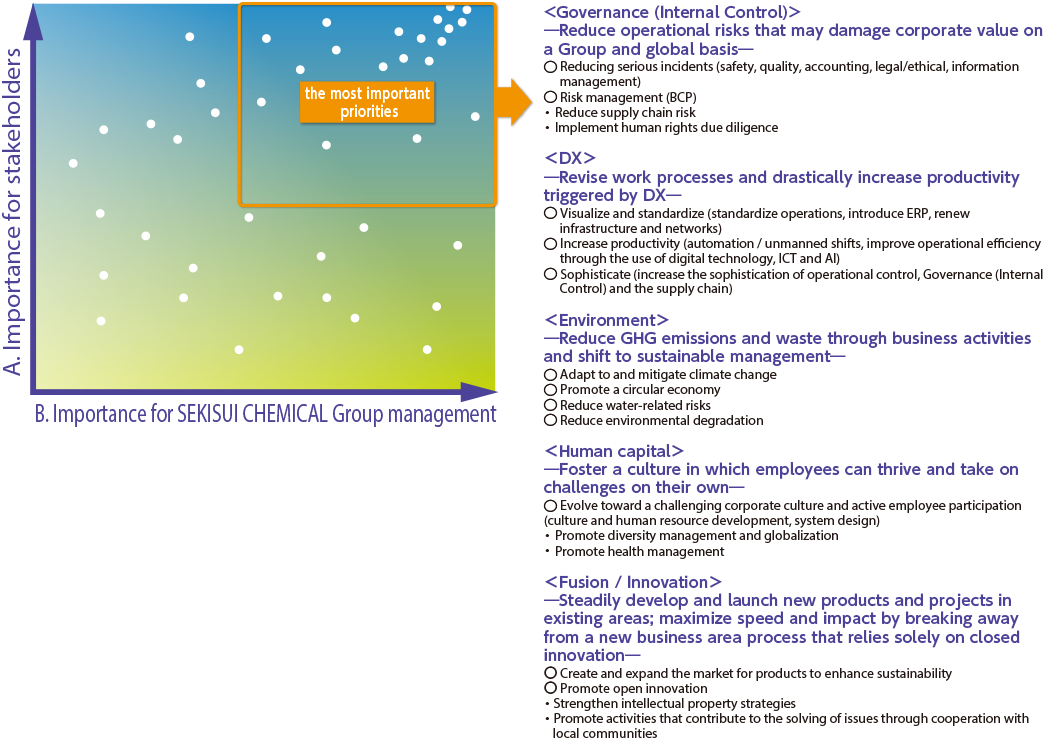Identifying Key ESG Issues
SEKISUI CHEMICAL Group Has Identified the Key Issues to be Addressed in Its ESG Management Efforts
Extracting and Identifying Key Issues
To strengthen still further ESG management, which is the key to realizing the Long-term Vision, Vision 2030, SEKISUI CHEMICAL Group has taken a revised look at important ESG issues and is promoting measures centered on Governance (Internal Control), DX, the environment, human resources, and fusion.
Identification Process for Key ESG Issues
Key ESG issues were identified based on the following processes.
Step 1. Consider issues from the global guidelines, etc.
- 07-06
- 07-07


-
(1)Identify candidate issues from the UN global compact (GC) and ISO26000
While adhering to the 10 principles in the GC, we examine the status of involvement within the Group for relevant activities and aspirations concerning each of the seven main core issues in ISO26000, and identify the points where involvement was insufficient. -
(2)Identify candidate issues by considering the boundaries both inside and outside the Group while considering the relationship between SEKISUI CHEMICAL Group and business regarding the economics, environmental, and social items described in the GRI standard.
-
(3)Analyze the social issues described in SDGs, and select the issues that provide business opportunities for SEKISUI CHEMICAL Group. In contributing to these solutions, we identify initiatives required for their success.
Step 2. Identify issues from ESG/CSR surveys and other companies’ trends
- 07-06
- 07-07

-
(1)Identify candidate issues from ESG/CSR surveys
We analyze issues based on the details of replies and evaluation results to each ESG and CSR survey, and identify candidate key ESG issues where future involvement can be considered important. -
(2)Analyze other companies’ ESG/CSR involvement and information disclosure trends
We examine involvement by other advanced ESG/CSR companies and trends in their disclosure using ESG/CSR reports, etc., and identify issues where improvements to SEKISUI CHEMICAL Group’s future involvement and information disclosure are to be desired.
Step 3. Analyze stakeholder opinions and expectations
- 07-09

-
(1)Sort major stakeholder opinions
We collect and sort the main opinions regarding ESG/CSR from the results of talking to various stakeholders such as customers, shareholders, investors, employees, trading partners, and local communities, etc. -
(2)Analyze major expectations by stakeholder
We factor in the main opinions from the various stakeholders described in (1) above, and analyze the main stakeholder expectations from their relationship to SEKISUI CHEMICAL Group business and ESG/CSR involvement.
Step 4. Identify key ESG issues
-
(1)Sort key ESG candidate issues
We add the CSR issues in which we have previously been strategically involved to the candidate ESG issues identified in steps 1 to 3 above to organize the candidates for key issues in ESG management. -
(2)Evaluate the importance of key ESG candidate issues
We evaluate the key ESG candidate issues sorted in (1) along two axes: A. Importance to stakeholders and B. Importance to SEKISUI CHEMICAL Group management, and identify the key ESG issues.
We then rank the key ESG issues that had been identified by priority. A. Importance to stakeholders is evaluated based on the viewpoints of stakeholder expectations, global trends, and positive and negative impact on the planet and society, and B. Importance to SEKISUI CHEMICAL Group management is based on the viewpoints of Conformance to management policy and management strategy, extent of compliance with ESG issues, risk and reputation, and priority considered on the time axis. Based on the Long-term Vision, Vision 2030, we evaluate A. Importance to stakeholders with the new application of the Sekisui Environment Sustainability Index*1 and B. Importance to SEKISUI CHEMICAL Group management with the added approach of using the SEKISUI Sustainable Spread*2 (taking ROIC and capital cost into consideration).
- *1 Please refer to Integrated Index
- *2 Please refer to Realizing Vision 2030
-
(3)Identify key ESG issues
The key ESG issues are discussed at Company management meetings, with items for implementation and management targets reviewed by the main departments before final internal approval is granted. Key management targets and items for implementation that have been approved are given suitable management through the PDCA cycle. As a rule, the key ESG issues will be reviewed and items for implementation and management targets will be set every three years when the medium-term management plan is created, though revisions will be discussed each year based on business conditions as well as social expectations and requirements.
- 07-10

Key ESG issues (2020-2022)
Issues where the importance for stakeholders is extremely high,
and is also extremely high for management of SEKISUI CHEMICAL Group
Governance (Internal Control)
- Reducing serious incidents (safety, quality, accounting, legal/ethical, information management)
- Risk management (BCP)
DX
- Visualization and standardization (standardize operations, introduce ERP, renew infrastructure and network)
- Increase productivity (automation / unmanned shifts, improve operational efficiency through the use of digital technology, ICT and AI)
- Sophistication (increase the sophistication of operational control, Governance (Internal Control) and the supply chain)
Environment
- Adapt to and mitigate climate change
- Promote a circular economy
- Reduce water-related risks
Human Resources
- Evolve toward a challenging corporate culture and active employee participation (culture and human resource development, system design)
Fusion
- Create and expand the market for Products to Enhance Sustainability
- Promote open innovation
Issues where the importance for stakeholders is high,
and is also high for management of SEKISUI CHEMICAL Group
- Strengthen intellectual property strategies
- Promote activities that contribute to the solving of issues through cooperation with local communities
- Implement human rights due diligence
- Reduce environmental degradation
- Promote globalization
- Promote diversity management
- Promote health management
- Strengthen the equipment maintenance system
- Reduce supply chain risk
